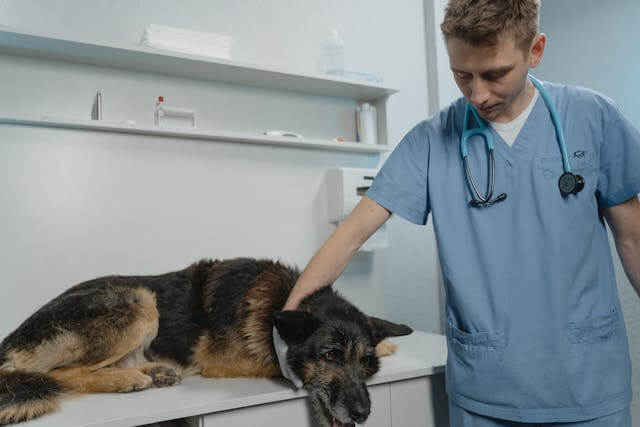Mange in dogs can be more than just a pesky skin condition; it’s caused by tiny mites and can lead to serious health issues if not addressed. Recognizing the signs early, such as hair loss and skin irritation, is vital to keeping your pet healthy. Mange comes in different forms, with Sarcoptic mange being highly contagious, requiring urgent attention.
Visiting a veterinarian is crucial for diagnosing mange accurately. A skin scraping can reveal the presence of mites and determine the right course of treatment. Treatment options vary, but they often include medicated shampoos, antibiotics, or special ointments to soothe the skin and eliminate the mites.
Long-term management is key in preventing recurrence and ensuring your dog’s immunity stays strong. Regular check-ups and using preventive measures can reduce the risk of mange returning. By staying informed and proactive, you can keep your furry friend happy and healthy.
Key Takeaways
- Mange is caused by mites and can lead to serious issues.
- Accurate diagnosis and timely treatment are crucial.
- Prevention and regular check-ups help maintain health.
Understanding Mange

Mange in dogs is caused by mites leading to irritation and hair loss. Two main types are sarcoptic mange and demodectic mange , each with unique causes and symptoms.
Etiology and Types of Mange
Mange is a skin condition caused by tiny mites. These parasites can live on or under your dog’s skin. The two most common types are sarcoptic and demodectic mange. Sarcoptic mange, also known as scabies, is caused by the Sarcoptes scabiei mite. This type is highly contagious and often spreads through direct contact with infected animals.
Demodectic mange, or red mange, is caused by Demodex mites . These mites are usually present on dogs but can multiply quickly if the immune system is weak. Unlike sarcoptic mange, demodectic mange is not contagious. Each type of mange requires a different approach for treatment, so identifying the cause is essential for effective care.
Comparing Sarcoptic and Demodectic Mange
When comparing these two types of mange, it’s important to look at how they affect your dog and how they spread. Sarcoptic mange causes intense itching, hair loss, and inflammation due to the burrowing mites. Your dog may develop irritated skin and scabs, particularly around the ears, chest, and elbows. This form spreads easily among pets and even to humans.
In contrast, demodectic mange primarily affects young or immune-compromised dogs. It leads to hair loss, skin redness, and irritation but is localized to small areas unless the immune system is severely compromised. It’s critical to seek veterinary advice to determine which type of mange your dog has, ensuring the appropriate treatment.
Symptoms of Mange in Dogs
Mange in dogs manifests through a range of signs that can affect your dog’s skin and overall well-being. Catching these symptoms early can help prevent the condition from escalating and causing severe discomfort.
Recognizing Early Signs
The early signs of mange often appear where the mites first invade the skin. You might notice symptoms such as redness or minor hair loss, especially around the dog’s ears, elbows, and belly.
Constant itching is a key indicator, as dogs tend to scratch persistently at affected areas. If untreated, these signs can spread and worsen, pointing to a larger infestation. Keep an eye out for small bumps, which may be raised on the skin’s surface.
Common Symptoms and Complications
As mange progresses, more prominent symptoms develop. Hair loss becomes more widespread, often showing as bald patches on your dog’s coat. Severe itching leads to constant scratching, potentially causing open wounds.
Look for thickening of the skin, which becomes rough and may crust over around areas like the ankles or armpits. Without treatment, mange can cause further complications, including emaciation and extreme discomfort due to the incessant itchiness and skin irritation. These symptoms require veterinary attention to ensure your pet returns to health.
Diagnosis of Canine Mange

Mange in dogs can affect their skin and coat health. Proper diagnosis is essential and typically involves both physical examination and specific tests.
Physical Examination and History
Your veterinarian starts by examining your dog’s skin and fur carefully. They look for signs like hair loss, redness, and itching.
During the examination, your vet will ask about your dog’s recent history. They’ll want to know about any contact with other animals and any changes in behavior or appearance. Observations of scratching and the location of affected areas help provide initial clues.
A clear history and physical signs allow the vet to determine if further testing is required to confirm mange presence.
Diagnostic Tests and Skin Scrapings
To diagnose mange, vets often perform a skin scraping. This involves taking a small sample of the top layer of skin.
The sample is examined under a microscope to identify mites like Demodex canis . These mites are easy to spot and indicate mange.
In some cases, hair samples are also analyzed. This process is crucial for distinguishing between different types of mange and planning the appropriate treatment. Skin scraping may cause mild irritation, but it’s a necessary and routine step.
Treatment Approaches

Mange treatment often includes medicated shampoos, oral medications, and environmental management strategies to effectively address the different aspects of the condition. Regular consultation with a veterinarian is crucial to ensure the most suitable treatment plan.
Medicated Shampoos and Topical Ointments
Medicated shampoos and topical ointments are common choices for treating mange in dogs. These products help soothe the skin and reduce inflammation. Ingredients like imidacloprid and selamectin are frequently used to kill mites and alleviate itching.
When using these treatments, follow your vet’s guidance closely. Apply the shampoo or ointment as directed to the affected areas, ensuring that the medication reaches the skin beneath the coat. This can help accelerate healing and improve your dog’s comfort during recovery.
Oral Medication Regimens
Oral medications provide another effective approach to mange treatment. These medications work systematically to kill mites and relieve symptoms from the inside out. Medications such as ivermectin or milbemycin oxime are often used, depending on your dog’s needs and health condition.
Your veterinarian will determine the appropriate dosage and frequency based on the severity of the mange and your dog’s size and overall health. It’s vital to complete the full course of medication to prevent recurrence.
Environmental Controls and Management
Managing your dog’s environment is essential in treating and preventing mange. Mites can survive in bedding and surrounding areas, so regular cleaning and sanitation are crucial. Wash bedding, toys, and other items frequently with hot water.
Consider using disinfectants on floors and surfaces to eliminate any lingering mites. Keep your dog’s living space as stress-free as possible, since stress can weaken the immune system. This helps in supporting a healthier recovery for your pet.
Managing Secondary Infections

When a dog has mange, the risk of secondary infections rises. These infections can include yeast, fungal, and bacterial skin infections. Proper management involves close observation and prompt treatment.
Identifying and Treating Yeast and Fungal Infections
Yeast and fungal infections can cause redness, itching, and a distinctive odor on your dog’s skin. Keeping an eye on these symptoms is crucial . If you suspect an infection, consult your vet for appropriate antifungal medications.
Topical treatments such as medicated shampoos can help. Ensure you follow the instructions given by your veterinarian. Regular baths with these treatments can effectively manage the spread and severity of these infections.
Make sure the dog’s living area stays clean and dry. Moist environments can worsen yeast and fungal problems, so frequent cleaning and ventilation are essential.
Dealing with Skin Infections
Skin infections often result from bacteria entering through inflamed skin. Symptoms include swelling, pus, and severe redness. Quick action can prevent complications .
Your vet may prescribe antibiotics to combat bacterial infections. Follow the dosage and complete the entire course to prevent resistance.
Gentle care is critical during the healing process. Avoid harsh materials that might irritate the skin further. Regular monitoring will help you notice any changes that need medical attention.
Hair Clipping and Skin Care
Hair clipping can prevent further skin issues by allowing air circulation. This reduces moisture that might encourage infection.
Choose a professional groomer if you are unsure how to clip safely. This step ensures an even trim and minimizes stress on your pet.
After clipping, keep your dog’s skin moisturized with vet-recommended lotions. Regularly check for any signs of irritation or abnormalities. By maintaining a clean and dry coat, you support faster recovery and better overall health for your pet.
Prevention and Control of Mange

Keeping your dog healthy and free from mange involves regular care and attention. You can lower the risk of mange through routine grooming, maintaining a clean environment, and taking precautions if your dog is at higher risk.
Regular Grooming and Check-ups
Regular grooming helps spot early signs of mange. This allows you to address issues before they become serious. Brush your dog’s coat frequently to keep it clean and free of debris that can harbor mites.
Visit your veterinarian for routine check-ups. Early detection of symptoms, like hair loss or skin irritation, can prevent mange from spreading or worsening. A balanced diet also strengthens your dog’s immune system, making them less susceptible to infections.
Environmental Hygiene
Keeping your dog’s living area clean reduces the risk of mite infestations. Wash bedding and toys regularly in hot water to kill any mites. Use pet-safe cleaners on surfaces to maintain hygiene.
Keep your yard clean and free from debris where mites might thrive. This helps prevent the spread of mange, especially if there are other animals around. Regular pest control treatments can also be beneficial in managing mites in your surroundings.
Proactive Measures for At-Risk Dogs
For dogs more prone to mange—such as those with weakened immune systems or mother dogs—additional care is needed. Ensure they are on flea or tick preventative medications. These treatments are effective against mange-causing mites as well.
Avoid exposing at-risk dogs to infected animals. If you know of a mange case nearby, prevent direct contact until the infected dog is treated. Keeping a close watch on these dogs can help manage their health more effectively.
Maintaining Overall Health and Immunity

Enhancing your dog’s health and immune system is key to managing and preventing mange. Keeping a balanced diet and reducing stress can make a significant difference.
Immune-Boosting Nutrition
Providing your dog with a nutritious diet helps support their immune system. A strong immune system can combat parasites and reduce symptoms of mange.
Feed your dog high-quality kibble or wet food rich in proteins and vitamins. Ingredients such as fish, chicken, and vegetables are beneficial.
- Omega-3 fatty acids: Found in fish oil, they help reduce inflammation and improve skin health.
- Vitamins C and E: Boost immunity and support skin repair.
Consider supplements, but always consult your vet before adding them to your dog’s diet.
Stress Reduction and Lifestyle
Minimizing stress is crucial for maintaining your dog’s health. Stress can weaken the immune system, making dogs more susceptible to mange.
Ensure your dog has a comfortable and clean living space. Regular exercise helps reduce stress and keeps your pet active.
Introduce toys and puzzles to engage your dog mentally. Socialization is important, but avoid contact with infected dogs until they are treated.
Routine: Consistent daily routines prevent anxiety. Maintain regular feeding, walking, and sleeping schedules to help create a stable environment.
Taking these steps can improve your dog’s quality of life and boost their ability to fight off mange effectively.
In conclusion, understanding mange in dogs is crucial for every pet owner who wants to ensure the health and well-being of their furry companions. By recognizing the symptoms of mange, such as excessive itching, hair loss, and skin inflammation, you can take timely action to seek veterinary care. Treatment options range from topical solutions to systemic medications, and early intervention can prevent complications. Remember, maintaining proper hygiene and a strong immune system is key to preventing mange outbreaks. By staying informed and vigilant, you can protect your dog from this common skin condition and ensure they lead a happy, healthy life.



